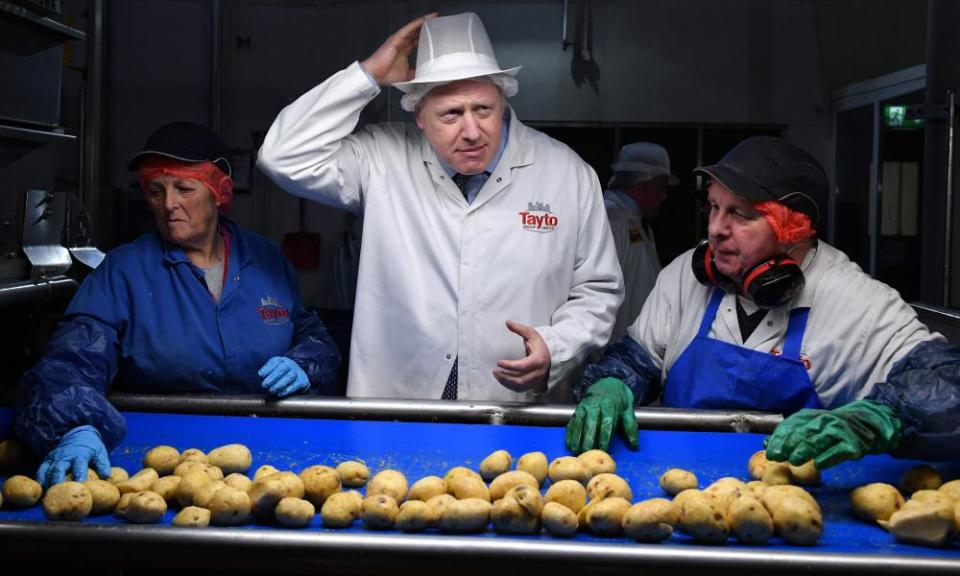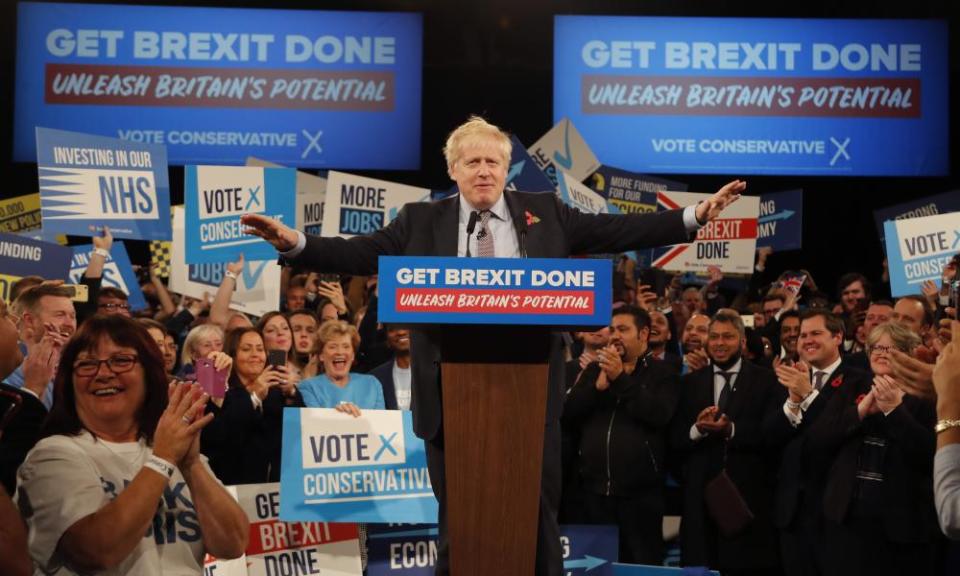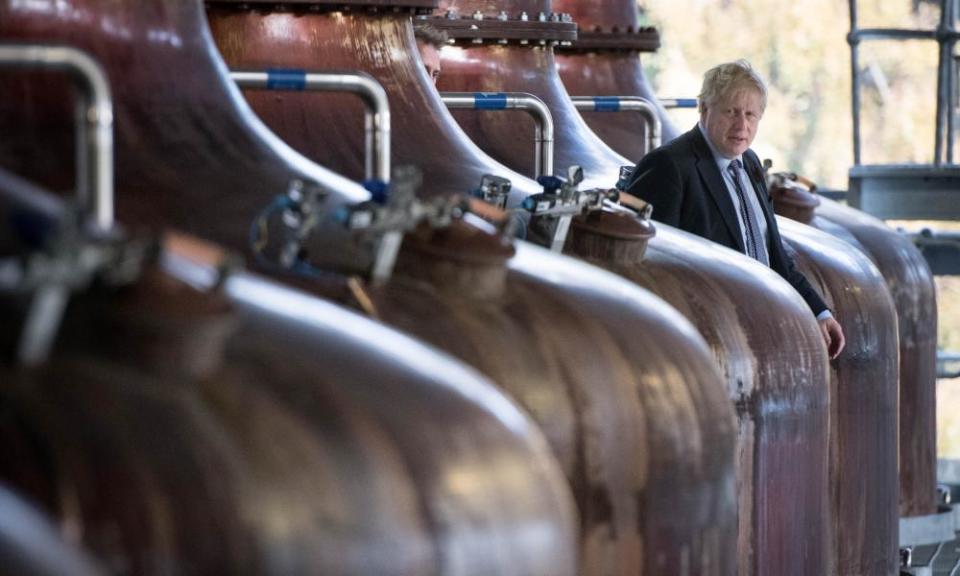Shifty shades of May: Boris Johnson dodges voters in week of election pain

Boris Johnson’s outriders used to boast during the 2016 referendum that unlike David Cameron, whose slick campaign events were carefully controlled, their man actually enjoyed the rough and tumble of getting off the Vote Leave bus and in among the public.
But at the end of this first gaffe-strewn week of the general election campaign, the prime minister has barely met a voter – aside from the Northern Irish manufacturers he addressed in a rambling speech on Thursday evening, during which he appeared to misconstrue his own Brexit deal.
It certainly was not the start the prime minister would have hoped for. The week began with Jacob Rees-Mogg being forced to apologise over remarks about the Grenfell Tower fire, and continued with Alun Cairns resigning as Welsh secretary over his support for a former aide whose testimony caused a rape trial to collapse.
Tory advisers were not shrugging off the seriousness of the Rees-Mogg comments or the Cairns debacle, saying the response to both of them indicated they knew both could have spiralled badly.
“They weren’t problems of our own making. So we did the only thing we could to make them not problems any more as fast as possible,” says one aide.
The same approach was taken again on Thursday night when a Tory candidate withdrew after being heavily criticised for having once said women should keep their knickers on to avoid rape.

After the disastrous start to the campaign, weary and worried cabinet ministers piled on a train to Birmingham on Wednesday night for the prime minister’s first stump speech of the campaign – some, such as the defence secretary, Ben Wallace, in first class and others such as the departing culture secretary, Nicky Morgan, braving it in standard along with hoards of journalists.
The event itself was like no previous Tory eve-of-election gathering. It had shades of a “Cameron direct” event where the former PM used to address activists with his sleeves rolled up, speaking without notes.
Conservatives
Alistair Burt North East Bedfordshire; Keith Simpson Broadland; Nicholas Soames Mid Sussex; Michael Fallon Sevenoaks; Nick Hurd Ruislip, Northwood and Pinner; Jo Johnson Orpington; Caroline Spelman Meriden; Claire Perry Devizes; Richard Benyon Newbury; David Jones Clwyd West; Mark Prisk Hertford and Stortford; Bill Grant Ayr, Carrick and Cumnock; Hugo Swire East Devon; Jeremy LeFroy Stafford; David Tredinnick Bosworth; Glyn Davies Montgomeryshire; Mark Field Cities of London and Westminster; Seema Kennedy South Ribble; Sarah Newton Truro and Falmouth; Richard Harrington Watford; David Lidington Aylesbury; Patrick McLoughlin Derbyshire Dales; Alan Duncan Rutland and Melton; Peter Heaton-Jones North Devon; Nicky Morgan Loughborough; Margot James Stourbridge; Mark Lancaster Milton Keynes North; Ross Thomson Aberdeen South; Henry Bellingham North West Norfolk; Nick Herbert Arundel and South Downs; Ed Vaizey Wantage; George Hollingbery Meon Valley
Labour
Kevin Barron Rother Valley; Paul Farrelly Newcastle-under-Lyme; John Mann Bassetlaw; Kate Hoey Vauxhall; Teresa Pearce Erith and Thamesmead; Stephen Pound Ealing North; Geoffrey Robinson Coventry North West; Stephen Twigg Liverpool West Derby; Jim Cunningham Coventry South; Ian Lucas Wrexham; Albert Owen Ynys Môn; Roberta Blackman-Woods City of Durham; Gloria De Piero Ashfield; Ronnie Campbell Blyth Valley; Jim Fitzpatrick Poplar and Limehouse; Ann Clwyd Cynon Valley; Owen Smith Pontypridd; Adrian Bailey West Bromwich West; Helen Jones Warrington North; Tom Watson West Bromwich East
Independent
Philip Hammond* Runnymede and Weybridge; Justine Greening* Putney; Rory Stewart* Penrith and the Border; Guto Bebb* Aberconwy; Oliver Letwin* West Dorset; Ken Clarke* Rushcliffe; Jared O'Mara** Sheffield Hallam; Louise Ellman** Liverpool Riverside; Amber Rudd* Hastings and Rye; John Woodcock** Barrow and Furness; Kelvin Hopkins** Luton North; Ian Austin** Dudley North; Sylvia Hermon North Down; Nick Boles* Grantham and Stamford
Liberal Democrats
Heidi Allen*** South Cambridgeshire; Sir Vince Cable Twickenham; Norman Lamb North Norfolk
Independent Group for Change
Ann Coffey Stockport; Joan Ryan Enfield North
Democratic Unionist Party
David Simpson Upper Bann
Speaker
John Bercow Buckingham
* Formally Conservative party
** Formally Labour party
*** Originally elected as a Conservative
But Johnson’s stunt really had more in common with the atmosphere of a Donald Trump or Jeremy Corbyn rally – albeit with a much smaller fan base than either of them.
A few hundred activists had turned up to welcome the prime minister, and were offered free XXL T-shirts bearing Tory campaign slogans in garish colours. They then brandished giant placards and chanted “Boris, Boris” as the prime minister came on to rock music.
The effect on the television was to present Johnson as surrounded by adoring fans, but when the cameras panned out it was obvious the spectacle was taking place in one small corner of a cavernous exhibition hall.
After providing a smiling, cheering backdrop, cabinet ministers traipsed back to London again – eating Subway sandwiches on the way from the only open eatery at Birmingham International railway station.
No 10 advisers have now moved over from Downing Street to Conservative party headquarters (CCHQ), where the team is led by Isaac Levido, the former right-hand man to the Australian election guru Sir Lynton Crosby.
Levido, along with Michael Brooks, the party’s pollster, sits at the centre of the room along with the campaign’s digital leaders.
However, there is no confirmation about the whereabouts of Dominic Cummings, Johnson’s controversial chief of staff who was due to have an operation in November. He told special advisers last week that Levido was “in charge”.
The election war room is so crowded that CCHQ is scrambling for extra desks, with a particularly big press team and social media operation – partly to compensate for the weaknesses of 2017’s digital operation when the Tories found themselves outgunned online by Labour and Momentum.

Cabinet ministers are also not being dispatched to many big campaign events this time, according to one adviser, supposedly because it eats into the limited spending budgets of local candidates. This leaves all their press aides stuck in CCHQ, staffing the phones and a rebuttal unit.
On Thursday, Johnson made a lightning visit to Moray in the north-east of Scotland, in a region where the Scottish Tories seized five of six available Westminster seats from the Scottish National party in 2017. Despite this potentially friendly territory, his preference for spending as little time in Scotland and being as far away from ordinary voters as possible – one trait he shares with his predecessor Theresa May – was evident.
Related: Scottish independence vote is price for support, SNP warns Labour
Johnson was questioned at length by journalists, who were perhaps irritable having been cooped up in a small room for several hours awaiting his arrival, about why his visits to Scotland since the summer had taken place in secure locations away from the general public, including a shipyard in Govan and Faslane nuclear base.
He insisted: “I’ve met many, many Scottish voters in the course of my time as prime minister and look forward to meeting many more.” Pressed on where and when these meetings had occurred, he repeated that he had met Scottish voters “loads of times”. When the Guardian suggested that this was not the case, Johnson joked: “You’re a voter aren’t you?”
After touring a rural distillery near Elgin for little more than an hour, Johnson was driven back to RAF Lossiemouth, and from there flew to Northern Ireland.
His meeting there with Northern Irish businesses, footage of which has gone viral, underscored why getting out among the public and speaking his mind may not be quite such an advantage for the prime minister as it was in 2016, when he was still regarded as a plucky outsider.

 Yahoo News
Yahoo News 